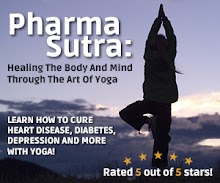Yoga as Integrative Medicine: Why Health Care Professionals Should Offer It
![]() Ginger Garner, Guest
Ginger Garner, Guest
Waking Times
In a 2002 study of people with chronic heart disease, more than 80% of patients used integrative medicine. (1) Patients cited numerous benefits to the use of integrative medicine, including maintaining better health and sleep, boosting self-esteem, hope, and peaceful mind, and reducing anxiety, stress, and pain. The integrative therapies used by the patients in the study were all modalities taught in the Professional Yoga Therapist Certification program, which include evidence-based yoga as integrative medicine, massage, relaxation, lifestyle-diet modifications, spiritual healing, herbs, and imagery.
Yoga as Integrative Medicine: What the Evidence Says
People are living longer than ever yet Americans’ quality of life is continually deteriorating. Pain associated with decreasing quality of life costs the US $635 billion dollars annually, says health economists at Johns Hopkins University published in the Journal of Pain. The National Institutes of Health reports ”pain is one of the most common conditions for which adults use complementary and alternative therapies.
Because chronic (long-term) pain can be resistant to many medical treatments and can cause serious problems, people who suffer from chronic pain often turn to complementary and alternative medicine (CAM) for relief.” A 2007 National Health Interview Survey reported “back pain was by far the most common condition cited as a reason for using CAM, followed by neck pain, joint pain/stiffness, and arthritis; other musculoskeletal pain and severe headache also ranked among the top 10 reasons.”
More than 80% of Americans suffer from low back pain at some point in their life. People are living with more chronic disease and pain, and as that happens, complementary and alternative medicine (CAM) is being sought out in greater numbers than ever. More than 32 billion dollars, 6 billion of that spent on yoga, was spent on integrative medicine in 2008. (3)
This statistic firmly places yoga in the top 10 integrative medicine modalities being used in the US today. The National Center for Complementary and Alternative Medicine recognizes yoga as a valid method for addressing low back pain. Additionally, yoga is proven effective in fighting inflammation and stress induced chronic disease, including heart disease, depression, obesity triggered diseases, pain, and immune function in cancer treatment. These are all conditions that top the list of causative pain agents, according to the American Academy of Pain Medicine. Read previous posts on Better Yogic Breathing for A Safer Spine and Why Yogic Breathing and Meditation Are Important Rehab Tools.
 Physical therapists, athletic trainers, and similar allied health professionals are ideally suited to be delivering yoga as medicine. Read Four Reasons Why Rehab. Pros Need Yoga. This is why Professional Yoga Therapy Studies currently offers graduate level studies in medical therapeutic yoga in partnership with three universities throughout North America. PYTS also offers the Professional Yoga Therapist post-graduate certification in partnership with Medbridge Education.
Physical therapists, athletic trainers, and similar allied health professionals are ideally suited to be delivering yoga as medicine. Read Four Reasons Why Rehab. Pros Need Yoga. This is why Professional Yoga Therapy Studies currently offers graduate level studies in medical therapeutic yoga in partnership with three universities throughout North America. PYTS also offers the Professional Yoga Therapist post-graduate certification in partnership with Medbridge Education.
A first of its kind, the PYT Certification is the national model for post-graduate certification in yoga for health care professionals. Studying yoga at a post-graduate level allows you to immediately apply yoga techniques in your clinical practice, which offers a more holistic and thorough approach to managing low back pain than physical therapy alone.
The PYTS program is interdisciplinary, which the Institute of Medicine lists as a critical element for improving chronic pain management in the US in its brief, Relieving Pain in America: A Blueprint for Transforming Prevention, Care, Education, and Research. Other elements critical for improving pain management and patient satisfaction in the US is use of integrative medicine’s biopsychosocial model, which is at the center of the Professional Yoga Therapist Certification.
About the Author
Ginger Garner MPT, ATC — is an educator and subject matter expert in medical therapeutic yoga and women’s health. As a published author and sought after speaker, Ginger pens the popular blog for mothers — Breathing In This Life (BITL –which is one of the columns in Yang-Sheng magazine and network). Ginger is founder of Professional Yoga Therapy (PYT), the first education program for Complementary and Alternative Medicine practice in medical therapeutic yoga in the US. Ginger’s focus is on education and activism for maternal and child health – through BITL, her school, PYT, through the organization she founded for Haiti relief in 2009, Musicians 4 Missions, and her work with the Initiative to Educate Afghan Women. Ginger has spoken and performed across the US to educate people about medical yoga and to raise awareness and funds for improving women’s health. As a working mother of three she has learned a thing or two about finding work/life balance through the healing arts, which she shares through BITL, at www.gingergarner.com.
Sources:
1. Ai LA, Bolling SF. The use of complementary and alternative therapies among middle-aged and older cardiac patients. AmJ Med Qual. 2002;17(21):21-271
2. National Institutes of Health 20007, National Health Survey.
3. Nahin RL, Barnes PM, Stussman BJ, Bloom B. Costs of complementary and alternative medicine (CAM) and frequency of visits to CAM practitioners: United States, 2007. Natl Health Stat Report 2009;(18):1-14.
Disclaimer: This article is not intended to provide medical advice, diagnosis or treatment. Views expressed here do not necessarily reflect those of WakingTimes or its staff.
This article is offered under Creative Commons license. It’s okay to republish it anywhere as long as attribution bio is included and all links remain intact.
~~ Help Waking Times to raise the vibration by sharing this article with the buttons below…